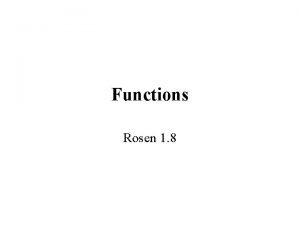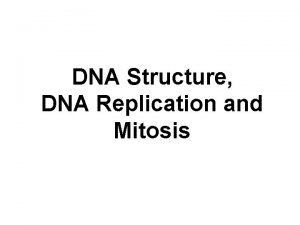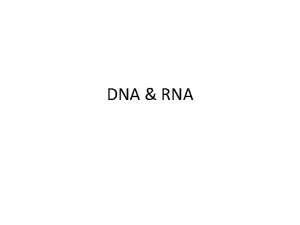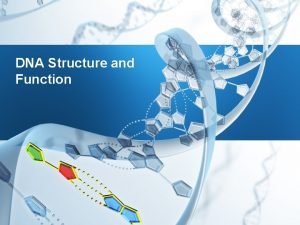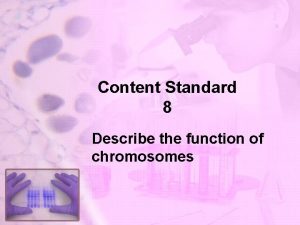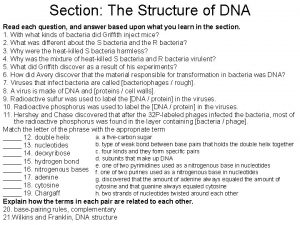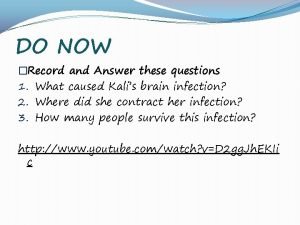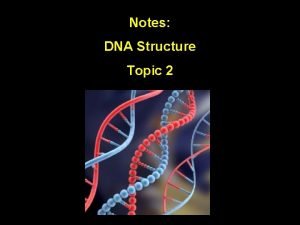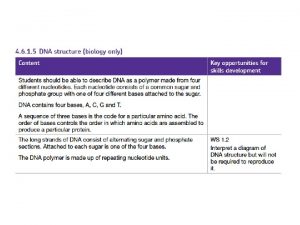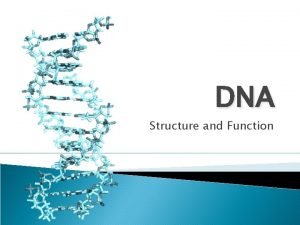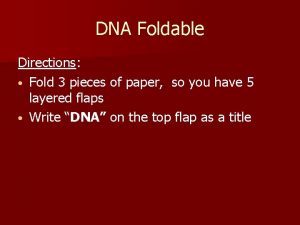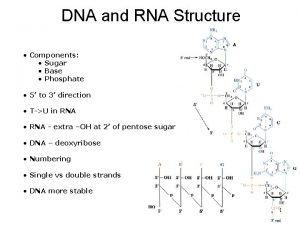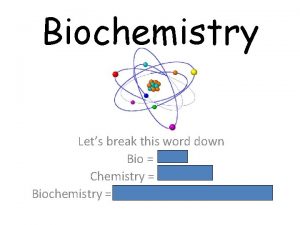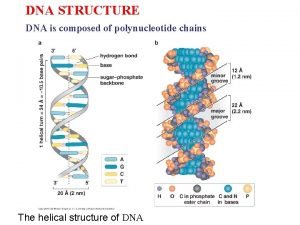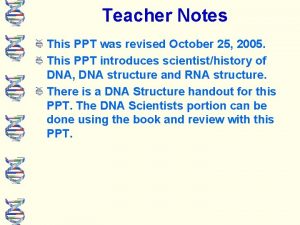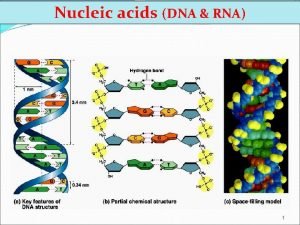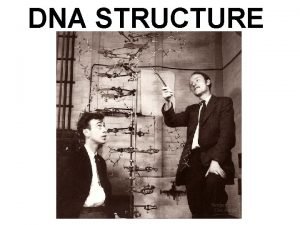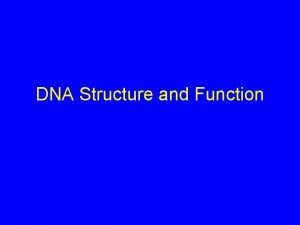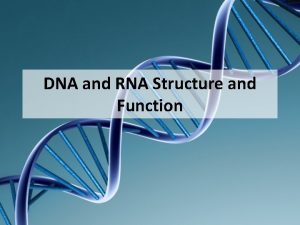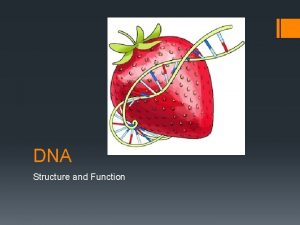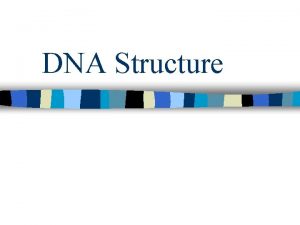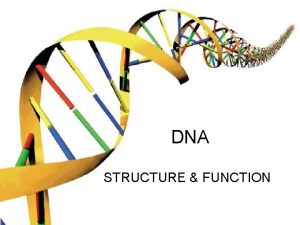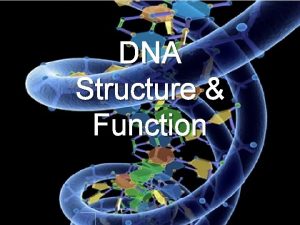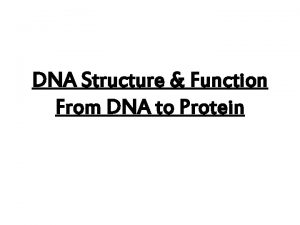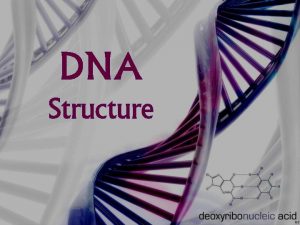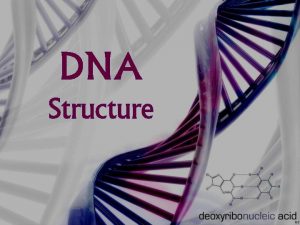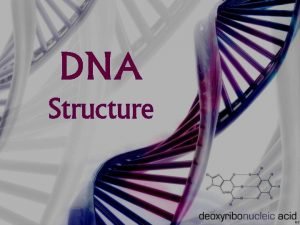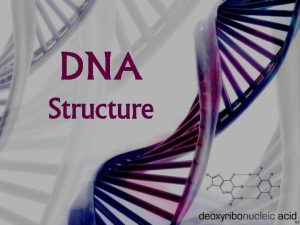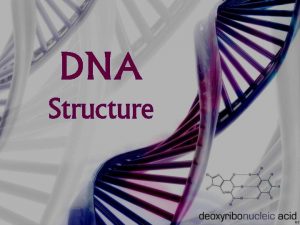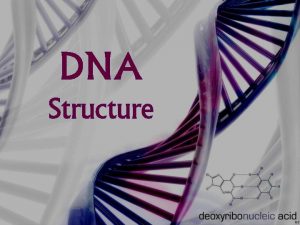DNA Structure and Function Not on mid 2






























- Slides: 30

DNA Structure and Function (Not on mid 2)

Nucleic Acids (polymer) • Monomer = nucleotides, the building blocks of nucleic acids • Structure = three parts: sugar, phosphate, and nitrogencontaining base

Sugar-Phosphate Backbone • Nucleotides connected together with a covalent bond. • Alternating sugars and phosphates

Nucleic Acids • DNA: Four bases: o o Adenine (A) Guanine (G) Thymine (T) Cytosine (C) • Sugar is deoxyribose • Double stranded • RNA: Four bases: o o Adenine (A) Guanine (G) Uracil (U, replaces T) Cytosine (C) • Sugar is ribose • Single stranded

Nitrogenous Bases • DNA -Four bases: o o Adenine (A) ad-den ēn Guanine (G) Thymine (T) Cytosine (C) • Memory trick, o pyrimidines have a “y” in the name

Base Pairing • DNA is 2 strands (molecules) held together by H-bonds • Bases form hydrogen bonds with each other – A pairs with T (& vc vs) – C pairs with G (& vc vs)

DNA Where are the H-bonds?

DNA Structure • The bonds between which 2 bases are stronger G&C or A&T? • H-bonds are very week, break & reform • W/ thousands of bases & thousands of bonds, DNA is held together

DNA • DNA is a polar molecule • It also has a negative charge • Dissolves well in water

Determining that DNA is the Genetic Material • Everyone knows …DNA…genetic material • This was not always known • Early studies. . microscopes. . genetic material was in the chromosomes – Made of both protein & DNA – Most biologist. . 1940. . protein as. . more complex. • Review experiments … DNA. . the genetic material

Griffith’s Experiment • 1928 • Two strains of bacteria – R – harmless (1) – S – deadly (2) • Heat killed Strain S is also harmless (3) • Something from heat killed Strain S makes Strain R deadly (4)

Avery, Mac. Leod, and Mc. Carty • • • 1944 Isolated compounds from Strain S Added these to Strain R DNA transformed Strain R into Strain S “Proved” DNA was the genetic material

Determining that DNA is the Genetic Material Head Tail fiber DNA 300, 000 • HERSHEY – CHASE: 1952 • Determined that the heredity material was DNA & not protein • Studied the bacteria virus T 2

Determining that DNA is the Genetic Material Phage Bacterium Radioactive protein DNA Batch 1 Radioactive protein Mix radioactively labeled phages with bacteria. The phages infect the bacterial cells. Batch 2 Radioactive DNA Empty protein shell Phage DNA Radioactivity in liquid Centrifuge Agitate in a blender to separate phages outside the bacteria from the cells and their contents. Pellet Centrifuge the mixture Measure the so bacteria form a radioactivity in pellet at the bottom of the pellet and the test tube. the liquid. Radioactive DNA Centrifuge Pellet Radioactivity in pellet

Determining that DNA is the Genetic Material • DNA in pellet, protein in the supernatant • The pellet contained the viral genetic material not the liquid supernatant • “Proving” DNA is the genetic material

The Structure of DNA • FRANKLIN and WILKINS: 1950’s • X-ray crystalography determined that DNA is a double helix

The Structure of DNA • WATSON and CRICK: 1953 • Determined that DNA was a double helix • Made a DNA model

Determining the Structure of DNA • • Watson & Crick later won the nobel prize Rosalind Franklin died of cancer young Brief video of photo 51 For more info see: http: //www. pbs. org/wgbh/nova/photo 51/

DNA Structure in more detail Two strands run in opposite directions

Nucleotide Functions Nucleotides Play Diverse Roles in Organisms: 1. Used as “energy currency” in cells (ATP) 2. Are chemical messengers of cells, (c. AMP) 3. Nucleotide coenzymes transport electrons and hydrogen atoms (examples: NADH and FADH 2) 4. Nucleotides also serve as building blocks for nucleic acids

Nucleic Acid Functions 1. DNA stores genetic information (traits and inheritance) 2. RNA translates this genetic info into protein

Organization of DNA • Eukaryotes – Billions of base pairs – several linear chromosomes – Genes not grouped – Mostly non-coding DNA – Nucleus? 22

DNA in the cell • Humans have 3 billion nucleotide base pairs • Roughly 6 feet of DNA in the nucleus of each cell • How does it all fit?

DNA Packaging • Eukaryotic chromosomes are very large • Must be packaged – Unavailable for transcription • Unpacking must occur before transcription

Levels of DNA Packaging • Fully condensed, seen at metaphase • Tightly packed loops • 30 nm fibers • Histone spool • Double helix

Gene Expression • Every cell in your body came from 1 original egg and sperm • Every cell has the same DNA and the same genes • Except the gametes which have half the DNA/genes 26

Gene Expression • Every cell has the same DNA, yet, each cell is different, specialized • How can they differ? • Due to gene expression – Which genes are turned on/off – How much product they make 27

Gene Expression • DNA must be copied faithfully when cells divide so that DNA is the same in all cells • Will have a lesson on gene expression

Chromosome Animation Review of of DNA Packaging • http: //www. biostudio. com/demo_freeman_ dna_coiling. htm • (Works in Internet Explorer, may not in Fire. Fox)

Organization of DNA • Prokaryotes – Several million base pairs one circular piece – Related genes grouped together – Mostly coding DNA – Nucleus? 30
 Function of dna polymerase 3
Function of dna polymerase 3 Coding dna and non coding dna
Coding dna and non coding dna Sadlier unit 1 level d synonyms
Sadlier unit 1 level d synonyms Bioflix activity dna replication nucleotide pairing
Bioflix activity dna replication nucleotide pairing What are the enzymes involved in dna replication
What are the enzymes involved in dna replication Dna rna protein synthesis homework #2 dna replication
Dna rna protein synthesis homework #2 dna replication Function vs not a function
Function vs not a function What is not a one to one function
What is not a one to one function Digit analysis hash function
Digit analysis hash function The poem mid term break
The poem mid term break Haploid vs diploid
Haploid vs diploid Dna structure and replication packet answer key
Dna structure and replication packet answer key Nature of dna replication
Nature of dna replication Dna and rna structure
Dna and rna structure Ikatan hidrogen
Ikatan hidrogen Cromosomas funcion
Cromosomas funcion Function of dna
Function of dna Function of dna
Function of dna Nucleic acids
Nucleic acids Dna structure
Dna structure Dna structure ppt
Dna structure ppt Describe the structure of dna *
Describe the structure of dna * Slidetodoc
Slidetodoc Bond between purine and pyrimidine
Bond between purine and pyrimidine Dna structure foldable
Dna structure foldable Dna bond structure
Dna bond structure Dna structure labeled
Dna structure labeled Structure of dna
Structure of dna Color 08252005
Color 08252005 Types of rna and dna
Types of rna and dna What does 3 and 5 mean in dna
What does 3 and 5 mean in dna







